Understanding Stackable Breeding Cages for Avian Care
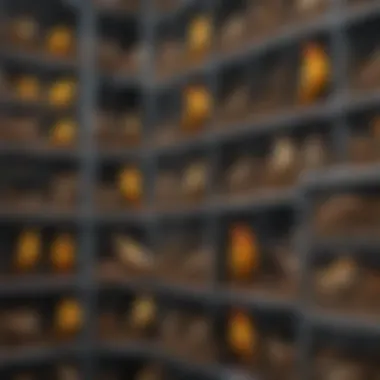
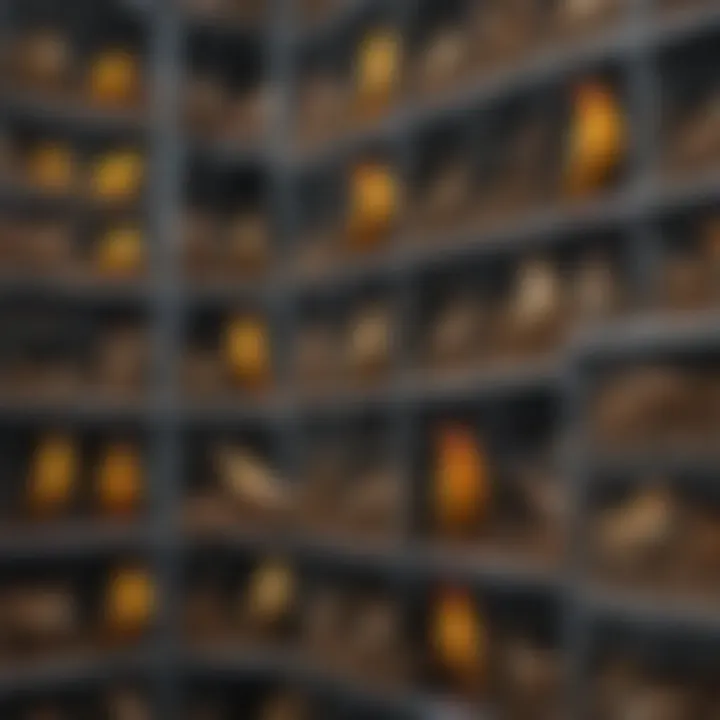
Intro
Stackable breeding cages serve as an essential tool for avian care, particularly for those who aspire to breed birds or manage a flock of pet birds. These cages are designed to maximize space efficiency while providing a practical environment for breeding. Understanding how these cages function, along with their implications on bird welfare, is crucial for both novice and experienced bird owners. This article delves into the significance of these breeding systems, highlighting key aspects that should be considered when choosing or maintaining stackable cages.
Care Tips
Daily Care Routines
Establishing a daily care routine is vital for the health and well-being of birds housed in stackable breeding cages. Owners should aim to check each cage daily, ensuring that food and water supplies are adequate. Observing bird behavior at this time can also provide insights into their health.
Cage Setup and Maintenance
Proper setup and maintenance are crucial for stackable cages. Cages should be placed in a well-ventilated area with appropriate lighting. Regular inspection is necessary to avoid wear and tear, which can lead to safety issues.
Hygiene and Cleaning Practices
Maintaining cleanliness is essential in any avian environment. Bacteria and pathogens thrive in unclean conditions. It is important to clean cages thoroughly on a weekly basis, using bird-safe cleaning products. Regularly change bedding materials and remove any leftover food to prevent mold and pests.
Seasonal Care Adjustments
Bird care needs may change with the seasons. In colder months, consider providing additional warmth, such as heat lamps. During warmer periods, ensure that the cages are well-ventilated and provide ample access to fresh water to keep birds hydrated.
Behavioral Insights
Understanding Bird Body Language
Birds communicate their feelings through body language. Learning to read these signals can be extremely beneficial. For instance, a bird with ruffled feathers may be stressed or cold, while a bird that mimics behavior may be seeking social interaction.
Common Behavioral Issues and Solutions
Common issues include excessive screeching or chewing on cage materials. Addressing these problems often requires patience and consistent efforts to redirect their behavior. Identifying the cause behind these behaviors is important for finding effective solutions.
Positive Reinforcement Techniques
Using positive reinforcement helps in building trust between the bird and its owner. Rewards for good behavior can include treats or extra playtime. This creates a stimulating environment that encourages positive behaviors.
Social Interaction Needs
Birds are social creatures and thrive on interaction. Ideally, they should be housed in pairs or groups. Ensuring opportunities for socialization can mitigate loneliness and stress, promoting overall happiness.
Nutrition Guides
Essential Diet Components
A well-rounded diet is vital for avian health. This typically includes a blend of seeds, pellets, and fresh fruits and vegetables. Understanding the specific needs of different species can enhance dietary choices.
Safe and Toxic Foods
Not all foods are safe for birds. For example, avocados and chocolate are toxic. Familiarizing yourself with which foods to avoid is just as important as knowing what to include in their diet.
Supplements and Treats
In certain cases, nutritional supplements can be beneficial. However, these should only be used sparingly and under veterinary guidance. Offering treats should also be done with care to avoid overfeeding.
Feeding Strategies for Different Species
Different species may have varying dietary requirements. For instance, larger parrots may need larger pieces of food, while smaller birds require smaller seeds. Understanding individual needs enhances the chances of successful feeding practices.
Wellness and Health
Routine Health Checkups
Regular health checkups by a qualified avian veterinarian are crucial. Early identification of any health issues can prevent more serious problems down the line.
Identifying Symptoms of Illness
Bird owners should be aware of common symptoms of illness, such as changes in eating habits or excessive feather plucking. Quick recognition can result in timely treatment.
Preventative Care and Vaccinations
Preventative care often includes vaccinations and periodic health assessments. Staying informed about vaccines for different species is an important part of a bird's health plan.
Mental and Emotional Well-being
Birds require mental stimulation to thrive. Providing a variety of activities and social interactions can keep their minds engaged, which is a crucial aspect of their overall well-being.
Enriching Activities
Toys and Playtime Ideas
Having toys in cages is essential. Different textures and functionalities keep birds active and interested. Rotating toys regularly can sustain their curiosity.
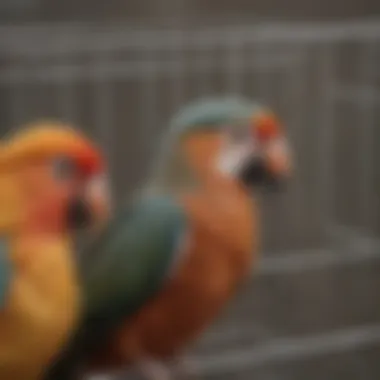
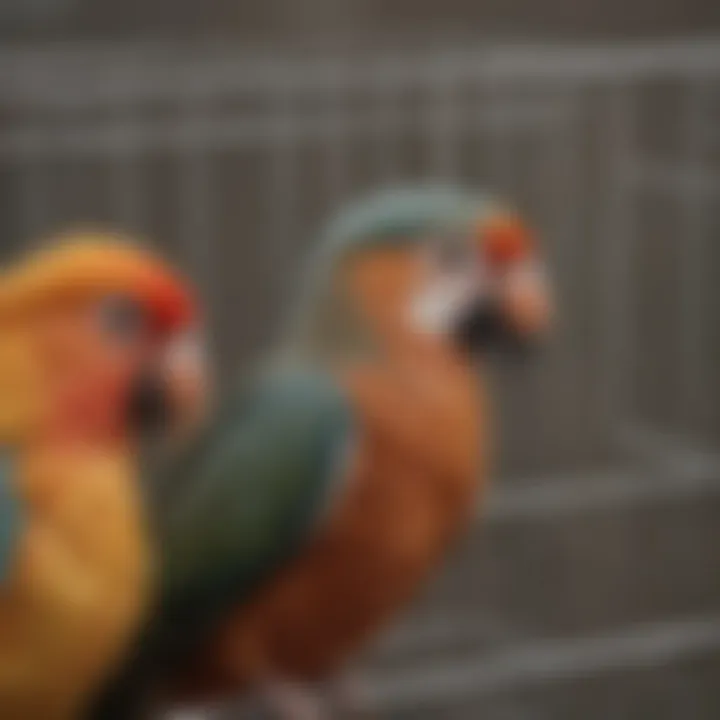
Training and Tricks
Training sessions not only stimulate birds mentally but also strengthen the bond with their owners. Basic commands can be taught using short, consistent sessions.
Outdoor Activities and Interaction
When conditions permit, allowing birds outside under supervision can enhance their quality of life. The fresh air and natural sounds promote a healthful environment.
DIY Projects for Mental Stimulation
Creating DIY enrichment toys can be a fun way to provide stimulation. Simple projects can involve using paper, wood, or safe household items that engage your bird’s interest.
Foreword to Stackable Breeding Cages
Stackable breeding cages represent a significant advancement in the realm of avian care. These structures facilitate a systematic approach to breeding birds, thereby enhancing efficiency. As bird enthusiasts and breeders seek ways to optimize their breeding environments, understanding the ins and outs of stackable breeding cages becomes crucial.
Bird owners thrive on providing the best possible care for their pets, and stackable cages offer a solution that maximizes space, promotes health, and ensures safe breeding. These cages allow for breeding setups that can accommodate multiple birds without overcrowding, which is essential for their well-being. Moreover, stackable systems often include features that support proper ventilation, access to food and water, and ease of cleaning, all of which are vital in maintaining a healthy environment.
Furthermore, considering ethical aspects, stackable cages can aid in better management of social interactions among birds. With careful planning, breeders can create spaces that cater to the natural behaviors of various bird species. Understanding these cages can ultimately lead to happier, healthier birds and more successful breeding outcomes.
As we delve into this topic, it will be important to examine the design, benefits, and key considerations of these systems. Through a structured exploration, we can unravel how stackable breeding cages can transform avian care, shaping both the experience of bird owners and the lives of their feathered companions.
Defining Stackable Breeding Cages
In the world of aviculture, the definition of stackable breeding cages holds significant weight. These cages are not mere enclosures; they are carefully designed environments that maximize space and enhance the breeding process for various bird species. The essence of stackable breeding cages lies in their ability to be stacked or arranged modularly, allowing breeders to optimize their setups without sacrificing the well-being of their feathered residents.
Importance of Stackable Breeding Cages
Defining stackable breeding cages involves considering key elements such as configuration, material, and functionality. These cages are typically constructed to allow for vertical stacking. This design approach is particularly beneficial for breeders with limited physical space. Practicality is central to their appeal, enabling efficient use of real estate while accommodating multiple breeding pairs or species.
Specific Elements to Consider
When selecting stackable breeding cages, several specifics must be taken into account:
- Space efficiency: As mentioned, the vertical design offers more breeding space within a confined area.
- Accessibility: Cages should be designed for easy access to birds, food, and cleaning. This is critical for maintenance and regular interactions with the birds.
- Safety features: The materials and design must reduce potential hazards to the birds. Strong materials ensure durability and safety during stacking.
Benefits and Considerations
By defining stackable breeding cages clearly, we arrive at a better understanding of their benefits. With a focus on space-saving and optimal breeding conditions, these cages help in managing bird populations effectively. They support various bird species' needs, ensuring that breeders can attend to each bird’s specific requirements.
Breeders must also consider potential drawbacks. For example, if not properly ventilated, stacked cages can restrict airflow, affecting the health of the birds inside. Therefore, proper ventilation design is as important as the stacking capability itself.
"Stackable breeding cages represent a strategic approach in aviculture, balancing efficiency with the necessity for bird welfare. Practices must align with the ethical care of birds to avoid compromising their living conditions."
In summary, defining stackable breeding cages extends beyond a mere description. It encapsulates the very principles that underpin effective bird breeding strategies. Such understanding leads to informed decisions, benefitting both the breeders and the avian population they nurture.
Benefits of Stackable Systems
Stackable breeding cages offer several pivotal advantages that extend beyond mere aesthetics. These benefits can significantly influence the decision-making process for bird owners and breeders alike. Understanding these advantages allows for a strategic approach to avian care, especially in environments where space and efficiency matter.
Space-saving advantages
One of the primary benefits of stackable systems is their ability to utilize vertical space effectively. In urban or smaller homes, floor space is often limited. Stackable cages enable multiple units to be placed on top of each other, which saves precious floor area. This approach is especially beneficial for breeders managing numerous birds or for pet bird owners with a variety of species.
Additionally, these cages can often be reconfigured or adjusted to fit changing spatial needs. For example, a bird enthusiast may start with fewer birds and later require more cages as their collection grows. A stackable system easily adapts to this evolution without necessitating a complete redesign of the setup. It is evident that spatial efficiency plays a crucial role in improving the living conditions for birds while simplifying management for their caretakers.
Optimal breeding conditions
Stackable breeding cages can create optimal breeding environments, which is tallied among the key benefits of such systems. Each cage can be tailored according to specific species requirements. Factors like temperature control, humidity, and lighting are essential in successful breeding practices. In many stackable designs, these elements can be managed independently across each unit.
Moreover, segregation of birds leads to less aggressive behavior. In a breeding scenario, it can also reduce stress and increase the likelihood of successful mating. With an appropriate setup, the welfare of the birds improves, which should be a primary consideration for any responsible breeder. The design and arrangement of these cages can facilitate the appropriate conditions needed for nurturing eggs and fledglings effectively.
Ease of management
Management is a critical factor in breeding success, and stackable systems excel in this area. This cage style enhances accessibility, which simplifies tasks such as feeding, watering, and cleaning. Most designs allow access from the front or top, ensuring that caretakers can maintain their routines without excessive strain.
In addition, with a stackable configuration, caretakers can set up specialized routines for each unit, adapting to the diverse needs of various bird species. For instance, a larger cage can house bigger birds, while smaller units are perfect for petite species. By organizing these cages according to species and needs, bird owners can streamline the care process.
Effective management reduces the probability of illness and fosters a healthier environment for birds.
Not only do these advantages improve day-to-day management, but they can also contribute positively to the overall breeding outcomes. The benefits inherent in stackable breeding cages are multifaceted and warrant consideration from all involved in avian care, ensuring a higher quality of life for birds while maintaining a manageable system for their owners.
Key Design Features
Understanding the design features of stackable breeding cages is crucial in ensuring optimal conditions for avian care. The design impacts not just the physical space but also the functional dynamics of breeding environments. Key design features encompass material selection, ventilation, and accessibility, each contributing significantly towards the welfare and breeding success of birds.
Material selection
Metal vs. Plastic
Choosing the right material for stackable breeding cages involves careful consideration of metal versus plastic. Metal cages, like those made from stainless steel, offer high durability and strength. They resist wear and tear, maintaining their integrity over time. Furthermore, metal can often be easier to clean, which is essential for hygiene.
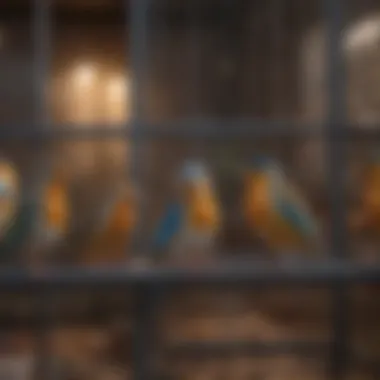
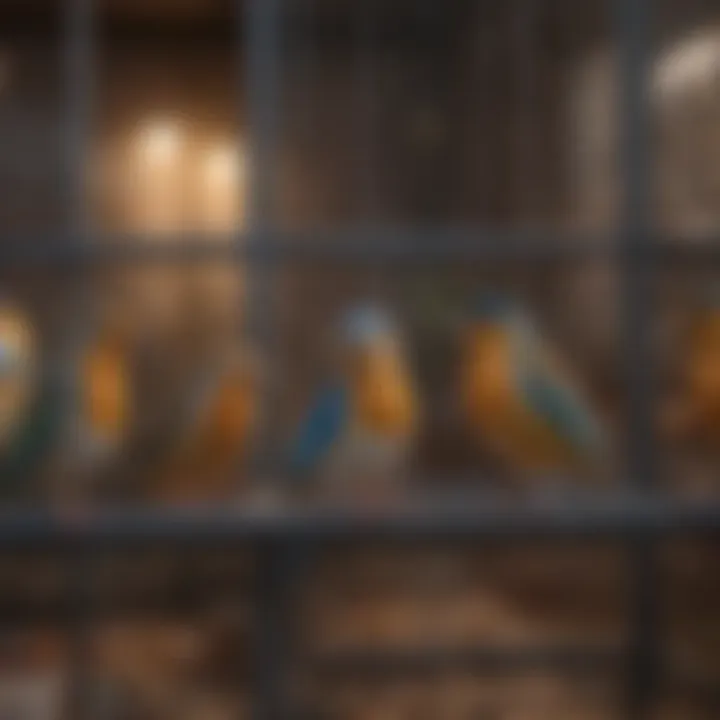
On the other hand, plastic cages can be lighter and more affordable, attracting many bird owners. The lightweight nature makes them easier to move and arrange. However, a potential downside is that plastic may not withstand aggressive behaviors from certain bird species as effectively as metal would.
Overall, both options have their merits, and the choice depends largely on the specific needs of the birds and the environment.
Durability considerations
Durability is a non-negotiable aspect for stackable breeding cages. The cages must withstand regular use without compromising safety. Metal, particularly when treated against rust or corrosion, often excels in this area. It can endure rough handling and frequent cleaning cycles without significant deterioration.
Conversely, plastic can be less durable, with the risk of cracking or fading after prolonged exposure to sunlight or cleaning agents. However, it is essential to balance durability with practicality, considering factors like weight and ease of installation.
Safety for birds
Safety is paramount in any breeding environment. The design should minimize risks like injury from sharp edges or toxic materials. Metal cages must be regularly checked for rust or rough spots that could harm the birds. A beneficial feature of safe designs is the use of non-toxic coatings or finishes, making metal a viable choice for many bird owners.
Plastic, typically smoother and less prone to rough edges, can also provide a safe environment. However, one must ensure the plastic used is free from harmful chemicals. Each choice demands thorough research to ensure the selected materials foster a beneficial living space for the birds.
Ventilation and airflow
Proper ventilation is vital in stackable breeding cages to maintain healthy air quality. Birds are sensitive to changes in their environment, and stale air can lead to respiratory issues. The cages should have sufficient openings to allow for consistent airflow while also ensuring that drafts do not disturb the birds. Good ventilation helps regulate temperature and avoids the buildup of moisture, which can contribute to the development of mold and bacteria. Solutions might include mesh panels or strategically placed vents that allow airflow without compromising security.
Accessibility
Accessibility in design enhances the experience of managing the cages effectively. The ease of reaching feeders and water sources is critical for the well-being of the birds. Cages should provide straightforward access to food and water without overcrowding. This approach enables regular replenishment and encourages birds to maintain a healthy eating routine.
Feeder and water access
Feeder and water access should be well thought out. Specialized designs, like exterior feeding ports, can keep the interior clean while allowing for easy refilling. An effective feeder design prevents spillage and waste, which is beneficial for hygiene. Furthermore, access should accommodate varying bird species, ensuring each bird receives their nutritional needs without competition or stress.
Cleaning and maintenance ease
Cleaning is an integral part of avian care. Cages must allow for quick and thorough cleaning to prevent both disease and odor. The design should promote ease of maintenance, with features like removable trays or smooth surfaces that do not trap debris. A cage that simplifies cleaning rituals can significantly enhance the overall management process for bird owners.
"Accessibility features not only ease maintenance but also contribute to the well-being of the birds."
Types of Stackable Breeding Cages
Understanding the types of stackable breeding cages is essential for anyone interested in avian care. Various designs fulfill different needs among pet bird owners, bird breeders, or aspiring bird parents. Each type of cage has its specific functions and advantages, allowing the user to select the best option according to their unique requirements.
Modular cages
Modular cages are highly versatile and adjustable, making them well-suited for various bird species. Owners can configure these cages in different arrangements or connect them to create a larger breeding unit. This modularity allows flexibility in handling birds of various sizes and behaviors. Moreover, they offer ease of expansion, which can be essential for breeders anticipating future growth in their operations.
Additionally, modular cages help optimize space, particularly in smaller environments. Each unit can be added or removed without needing to redesign the overall layout. This adaptability is crucial for those managing multiple species, where individual requirements might differ significantly.
Stackable racks
Stackable racks provide a practical solution for efficient space use. Unlike traditional cages, these racks consist of multiple stacks, which allow for vertical organization. They are particularly advantageous when floor space is limited. Bird owners can establish a compact breeding environment that does not compromise the health and comfort of the birds.
These racks often come with various sizes and configurations. Some designs may include integrated feeders or water systems, making them more convenient. Due to easy access, users can monitor bird health and welfare without much hassle. The management of such systems becomes more straightforward, which is vital for individuals dedicated to maintaining optimal breeding conditions.
Customizable units
Customizable units offer a wealth of options for those who want more control over their set-ups. Owners can modify these cages based on specific objectives, such as breeding traits or social structures. The ability to adjust dimensions, partitions, and features enhances the adaptability of these systems.
Customization extends to the materials used, ventilation options, and even additional accessories like perches, toys, or enrichment activities. This capability ensures that each bird's welfare is considered from an individual perspective. When breeders can create environments that align with their birds' natural instincts and requirements, it fosters better growth and breeding outcomes.
Ultimately, selecting the right type of stackable breeding cage is foundational for successful avian care. By understanding the distinct characteristics and benefits of modular cages, stackable racks, and customizable units, bird owners can make informed choices that reflect their unique needs.
Selecting the Right Cage for Your Birds
Choosing the correct cage is a pivotal aspect of avian care. The right cage will cater to the needs of the birds, ensuring their health and comfort. It also simplifies management for the bird owner. When selecting a cage, there are two main considerations to keep in mind: the requirements of specific bird species and the long-term breeding goals.
Assessing Bird Species Needs
Size Considerations
Size is a critical factor when selecting a cage. Different species require varying amounts of space to thrive. Larger birds, such as macaws or cockatoos, need more room to move around, stretch their wings, and engage in natural behaviors. In contrast, smaller species like budgerigars or finches can be housed in smaller enclosures.
A key characteristic of size considerations is that the cage dimensions should be proportional to the bird’s size. This aspect is crucial because an adequately sized cage encourages exploration and activity, thereby reducing boredom and promoting mental health.
One unique feature of size considerations is the recommendation of minimum dimensions. Most bird care experts suggest specific height, width, and length measurements based on bird species. A cage that is too small can lead to physical issues, such as deformities in wing development or psychological stress due to confinement.
Behavioral Requirements
Behavioral requirements significantly influence cage selection. Birds are social animals with various behavioral needs that must be met. This includes the need for vertical space, which allows for climbing, an essential behavior for many species. An ideal cage setup accommodates perches at different heights and suitable toys that encourage natural activities.
The key characteristic of behavioral requirements lies in understanding how birds interact with their environment. The right cage should allow for socialization with other birds or owners, reducing anxiety and promoting overall well-being. For example, finches thrive in colony settings, while pet parrots appreciate interaction with humans.
A unique feature in this regard is the inclusion of enrichment tools. Toys, swings, or foraging devices that stimulate mental activity are vital. Choosing a cage that facilitates these aspects can greatly improve a bird's quality of life. However, if the cage is too cluttered, it can overwhelm some sensitive species, which is a point to consider when designing the habitat.
Considering Breeding Goals
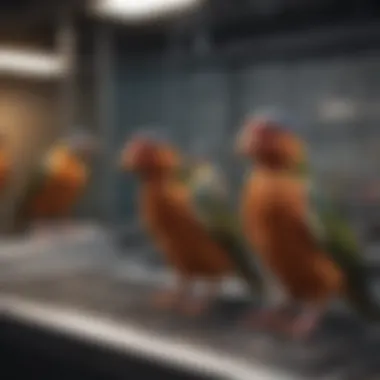
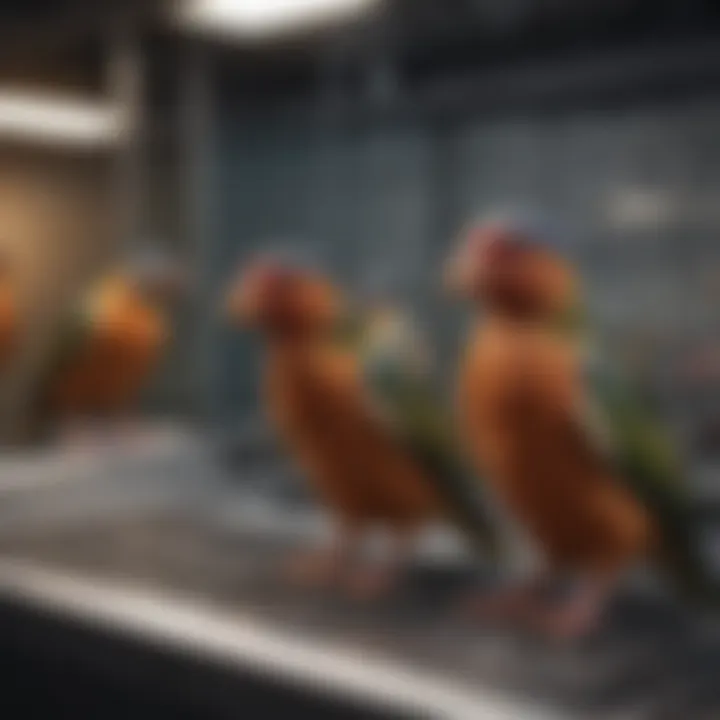
When focusing on breeding, one must have clear goals. Understanding the breeding objectives helps in selecting a suitable cage. If the aim is to breed specific species, it’s important to consider compatibility and breeding pairs. The design of the cage should facilitate breeding behaviors, which may include nesting areas and privacy.
Breeding cages often require more substantial investments. It's vital to account for the costs associated with larger or specialized cages. Additionally, consider the long-term implications of these goals on cage selection. A cage suitable for breeding should not only meet current needs but also adapt to future considerations as the breeding project evolves.
Selecting the right cage for birds is not just about aesthetics but ensuring optimal health and promoting natural behaviors.
By meticulously evaluating the species-specific needs and aligning those with breeding objectives, bird owners can create an environment conducive to the welfare of their feathered companions.
Welfare Aspects of Stackable Breeding Cages
The welfare of birds in captivity is a fundamental consideration when designing breeding environments. In the context of stackable breeding cages, understanding various welfare aspects is critical. Stackable systems can enhance or hinder the well-being of birds, depending on design choices and management practices. This section examines social interactions and stress management, which are essential components for maintaining a healthy atmosphere for avian care.
Social interactions
Birds are inherently social creatures. Their well-being is often tied to their interactions with others of their kind. When utilizing stackable breeding cages, one should consider how these systems impact the social dynamics between birds. The opportunities for visual and auditory contact between birds in different levels of stacked cages can influence behavior positively. For instance, some species thrive when they can see or hear their companions, as this can prevent loneliness and promote natural behaviors.
However, caution is necessary. Overcrowding or inappropriate species combinations can create aggressive behaviors. Therefore, avian care practitioners should assess each species’ social needs when arranging birds in these cages. Providing adequate spaces for nesting and retreat is also important. This balance ensures birds can interact without feeling trapped or threatened.
Stress management
Stress can be a serious concern in bird breeding. Stackable cages must minimize stressors to ensure healthy breeding cycles and overall bird health. High noise levels, poor airflow, or restrictive spacing can increase stress levels among birds. Effective management techniques focus on creating a serene environment within stacked cages.
Factors such as proper ventilation and the arrangement of cages play vital roles in managing stress. Good airflow helps reduce heat and humidity, which can be stressful for birds. Regular monitoring of environmental conditions assists in maintaining an appropriate atmosphere. Furthermore, establishing a consistent routine for handling and caring for the birds can provide a sense of security, minimizing surprises that may trigger anxiety.
Ultimately, the welfare aspects of stackable breeding cages play a significant role in the health and happiness of captive birds. Addressing social needs and stress management leads to more successful breeding outcomes and healthier birds.
Understanding these welfare dimensions allows bird owners and breeders make informative decisions regarding cage design and management, ensuring a supportive environment for their feathered companions.
Maintenance and Hygiene
Maintaining proper hygiene in stackable breeding cages is crucial for the health and well-being of avian species. Birds are particularly susceptible to various infections and diseases, many of which can be exacerbated by poor living conditions. A focus on both maintenance and hygiene helps ensure a safe environment for breeding and can improve overall breeding success.
Regular upkeep of cages reduces the risk of stressors that birds experience in unsanitary conditions. Clean cages support optimal health and promote positive behavior in birds. When cages are well-maintained, it significantly decreases the likelihood of disease outbreak, which benefits both the birds and breeders.
A robust cleaning routine will not only enhance the living conditions for birds but also extend the lifespan of the cages. Keeping cages and their components clean ensures that they do not become breeding grounds for bacteria or mold, which could have severe health implications. Let’s explore the specifics of establishing a proper maintenance plan.
Regular cleaning protocols
Developing a systematic approach to cleaning is essential. This includes daily, weekly, and monthly tasks.
- Daily Cleaning: Remove leftover food and waste from the cages. This should be done every day to prevent attracting pests and to avoid overgrown bacteria. Check water daily, refreshing it as needed.
- Weekly Cleaning: Each week, a deeper cleaning should take place. This involves removing all items from the cage, such as feeders and perches. Use a safe, non-toxic cleaner to scrub the interior surfaces. It is advisable to rinse thoroughly to ensure no cleaning residue remains, as this can harm birds.
- Monthly Cleaning: Every month, perform a thorough inspection of the entire setup. Check for any wear or damage. Replace items showing signs of wear, such as torn liners or frayed ropes. It's also the time to disinfect using a veterinary-recommended solution to eliminate pathogens.
Implementing these protocols ensures that cages remain not only clean but also safe for the inhabitants.
Preventing disease transmission
One major concern with breeding birds is their vulnerability to disease. Stackable breeding cages can make it easier to contain and manage potential outbreaks if proper hygiene is maintained. Here are some key practices for preventing disease transmission:
- Isolation: Minimize contact between different species or flocks. If a bird shows signs of illness, it should be isolated immediately to reduce the risk to others.
- Shared Equipment: Be cautious with tools and equipment; they can be a vessel for pathogens. Clean items like feeders, waterers, and cleaning tools with a disinfectant regularly to avoid cross-contamination.
- Footwear and Clothing: Change shoes and clothes when entering a breeding area. Contaminated footwear can transfer harmful organisms. Use foot baths with disinfectant at the entry point to breeding areas.
"A clean cage is more than just aesthetics; it is a sanctuary for health, breeding success, and bird happiness."
By establishing rigorous cleaning and maintenance protocols, a bird owner can significantly enhance the overall environment in which their avian companions live. This promotes a healthy breeding atmosphere, reduces the risk of disease, and ensures each bird thrives.
Cost Considerations
Cost considerations are fundamental when discussing stackable breeding cages for avian care. Investing in these cages goes beyond the initial purchase price; it involves evaluating long-term financial implications and their impact on the overall breeding operation. Understanding these costs helps bird owners make sound decisions that balance quality with affordability, ensuring that the welfare of their birds remains a priority while optimizing their breeding environments.
Initial investment
The initial investment in stackable breeding cages can vary widely depending on several factors. One must consider the size, material, and design of the cages. For example, high-quality metal cages might be more expensive upfront than plastic alternatives but often offer better durability. The customization options can also affect the cost. Additionally, purchasing in bulk might yield discounts if one is looking to create a larger setup.
When estimating the initial costs, bird owners should include not just the cages themselves but also necessary accessories, such as feeders and water bottles. It is wise to conduct thorough research to compare prices from different suppliers and evaluate what best fits their budget without compromising on the welfare of their birds.
Long-term expenses
While the initial investment is critical, it is equally, if not more important, to consider the long-term expenses associated with stackable breeding cages. Regular maintenance and cleaning are essential for bird health and comfort. The costs associated with cleaning supplies, tools, and the potential need for repairs should be accounted for.
Moreover, energy costs for heating and lighting in a breeding setup can add up over time. An efficient design can lessen these costs, but it’s crucial to estimate these expenses when calculating the overall financial commitment.
Additionally, consider the health implications of insufficient or improper caging. If the cages do not promote bird well-being, one might incur higher veterinary bills.
"A well-thought-out investment in quality cages can lead to healthier birds, reducing the chances of unforeseen medical expenses."
The End
In this article, we have explored the various aspects of stackable breeding cages and their relevance in avian care. The proper selection and usage of these cages can significantly impact the health and welfare of pet birds. Key elements like design features, maintenance routines, and adaptability to different bird species have been discussed in detail.
The decision to use stackable cages offers multiple benefits. These cages maximize space, allowing bird owners to house more birds in a limited area without compromising their well-being. In addition, well-designed stackable systems promote optimal breeding conditions. They allow for tailored environments that can be adjusted to meet specific needs for different bird species.
When considering the welfare aspects, the cages allow for social interactions, while also providing strategies for stress management. Understanding how to mitigate stressors associated with housing birds in close quarters is crucial for any aviculturist.
Moreover, maintenance and hygiene are fundamental in preventing disease transmission. Establishing a regular cleaning protocol will ensure that birds remain in a healthy environment, lowering the risk of outbreaks.
Lastly, evaluating the costs associated with both the initial investment and long-term care in stackable systems can help foster better financial planning and sustainability in breeding practices.
In summary, the insights shared in this article aim to equip novice and experienced bird owners alike, with the knowledge necessary to make informed decisions regarding their breeding environments. Making the right choices ensures not only the health and well-being of their birds but also contributes positively to the broader avian care community.















